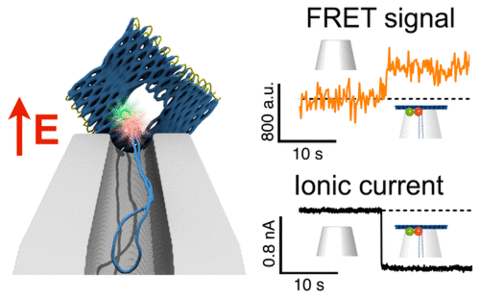Optical voltage sensing using DNA origami

We explore the potential of DNA nanotechnology for developing novel optical voltage sensing nano-devices that convert a local change of electric potential into optical signals. As a proof-of-concept of the sensing mechanism, we assembled voltage responsive DNA origami structures labelled with a single pair of FRET dyes. The DNA structures were reversibly immobilised on a nanocapillary tip and underwent controlled structural changes upon application of an electric field. The applied field was monitored through a change in FRET efficiency. By exchanging the position of a single dye, we could tune the voltage sensitivity of our DNA origami structure, demonstrating the flexibility and versatility of our approach. The experimental studies were complemented by coarse-grained simulations that characterised voltage-dependent elastic deformation of the DNA nanostructures and the associated change in the distance between the FRET pair. Our work opens a novel pathway for determining the mechanical properties of DNA origami structures, and highlights potential applications of dynamic DNA nanostructures as voltage sensors.
Capture of the DNA origami voltage sensor by a nanocapillary under a range of applied biases (100-400). The DNA origami was modeled using a low-resolution coarse-grained description that represented ~5 base pairs with each bead.
At a bias of 600 mV, the origami object rapidly deforms and passes through the nanocapillary, in agreement with experiment.
Observation of FRET dye pair separations in high-resolution coarse-grained simulations of the captured plates. The initial configuration of each plate was obtained from the end of the corresponding capture simulation. Here, two beads were used to describe each base pair, providing a local representation of the DNA twist.